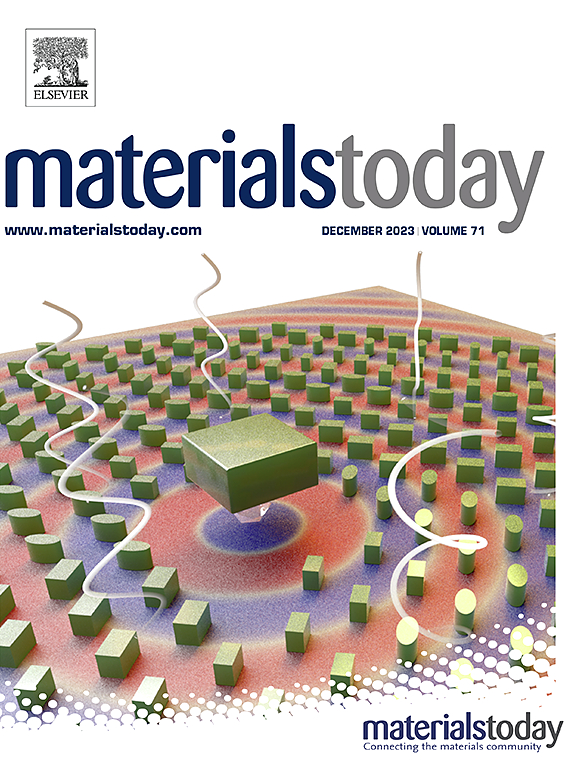Bioinks with varying densities of physical and chemical crosslinks modulate cellular responses in 3D by altering the viscoelasticity of the cell microenvironment
IF 21.1
1区 材料科学
Q1 MATERIALS SCIENCE, MULTIDISCIPLINARY
引用次数: 0
Abstract
The biological function and clinical translation of bioprinted cell-laden constructs largely depend on the bioink printability and biomechanical cues presented to embedded cells. Despite multiple biomaterials and crosslinking reactions have been explored for bioink design, how the type and density of crosslinks used in bioink development determine the relationship between bioink printability and viscoelasticity, and how in turn the resulting alterations in viscoelasticity regulate cell behavior within 3D bioprinted constructs remain largely unknown. Here, we developed double crosslinked bioinks with controllable printability and time-dependent mechanical properties by varying the density of reversible (ionic) to static (thioether) crosslinks in the gel network. We utilized these bioinks to investigate how the altered density of physical and chemical crosslinks affects the viscoelasticity of bioprinted cell constructs and how they regulate fundamental cellular responses in 3D. From our results, it was evident that increased density of reversible bonds in bioprinted constructs significantly promotes not only rapid cell spreading, but also the formation of interconnected cellular networks by enhancing matrix viscoelasticity and stress relaxation. By co-printing bioinks whose viscoelasticity can be adjusted independently from its cell-adhesiveness by varying the degree of covalent crosslinking via photoclick thiol-ene reaction, we showed that cell spreading and morphology are spatially regulated in step-gradient hydrogels by the viscoelasticity of their surrounding environment. Our findings reveal that bioinks with similar printability elicit distinct cell responses in bioprinted 3D constructs via altered matrix viscoelasticity, which is determined by the type and density of crosslinks employed for bioink crosslinking. Taken together, these results underscore matrix viscoelasticity as a key parameter in the rational design of mechano-instructive bioinks for bioprinting applications in tissue repair and in vitro tissue modelling.
具有不同密度的物理和化学交联的生物墨水通过改变细胞微环境的粘弹性来调节三维细胞反应
生物打印细胞负载结构的生物学功能和临床翻译在很大程度上取决于生物链接的可打印性和提供给嵌入细胞的生物力学线索。尽管已经探索了多种生物材料和交联反应用于生物墨水设计,但生物墨水开发中使用的交联的类型和密度如何决定生物墨水可打印性和粘弹性之间的关系,以及由此产生的粘弹性变化如何反过来调节3D生物打印结构中的细胞行为,在很大程度上仍然未知。在这里,我们通过改变凝胶网络中可逆(离子)和静态(硫醚)交联的密度,开发出具有可控印刷性和随时间变化的机械性能的双交联生物墨水。我们利用这些生物墨水来研究物理和化学交联密度的改变如何影响生物打印细胞结构的粘弹性,以及它们如何在3D中调节基本的细胞反应。从我们的研究结果来看,生物打印结构中可逆键密度的增加不仅显著促进了细胞的快速扩散,而且通过增强基质粘弹性和应力松弛,还显著促进了相互连接的细胞网络的形成。通过共打印生物墨水,其粘弹性可以通过光点击巯基反应改变共价交联的程度而独立于其细胞粘附性进行调节,我们发现在阶梯梯度水凝胶中,细胞的扩散和形态在空间上受其周围环境的粘弹性调节。我们的研究结果表明,具有相似可打印性的生物墨水通过改变基质粘弹性,在生物打印3D结构中引起不同的细胞反应,这是由用于生物墨水交联的交联的类型和密度决定的。综上所述,这些结果强调了基质粘弹性是合理设计用于组织修复和体外组织建模的生物打印应用的机械指导性生物墨水的关键参数。
本文章由计算机程序翻译,如有差异,请以英文原文为准。
求助全文
约1分钟内获得全文
求助全文
来源期刊

Materials Today
工程技术-材料科学:综合
CiteScore
36.30
自引率
1.20%
发文量
237
审稿时长
23 days
期刊介绍:
Materials Today is the leading journal in the Materials Today family, focusing on the latest and most impactful work in the materials science community. With a reputation for excellence in news and reviews, the journal has now expanded its coverage to include original research and aims to be at the forefront of the field.
We welcome comprehensive articles, short communications, and review articles from established leaders in the rapidly evolving fields of materials science and related disciplines. We strive to provide authors with rigorous peer review, fast publication, and maximum exposure for their work. While we only accept the most significant manuscripts, our speedy evaluation process ensures that there are no unnecessary publication delays.
 求助内容:
求助内容: 应助结果提醒方式:
应助结果提醒方式:


